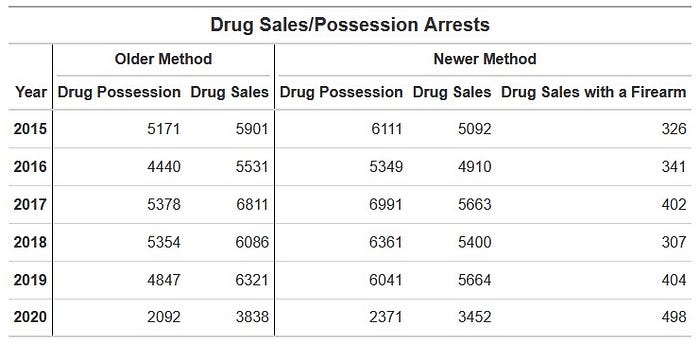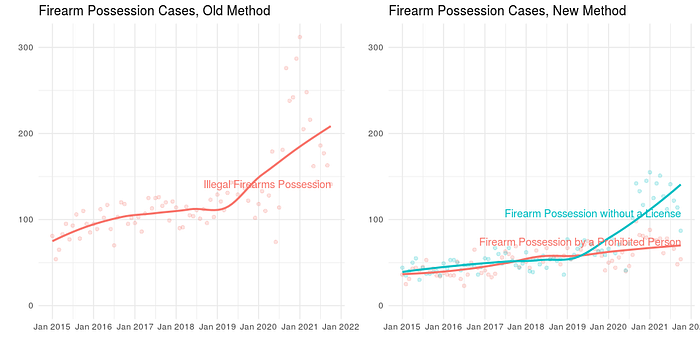
On December 14, 2021, we changed the way we are categorizing arrests and cases on the Public Data Dashboard. The new method of categorization allows us to more accurately describe how cases move through the system, from incident to arrest to court involvement. Although this change will result in some individual arrests or cases being categorized differently, it does not change our counts of the overall number of cases in the system.
How We Used to Classify Arrests and Cases
To understand how we changed our categorization method, it is important to first understand how we have historically categorized arrests and cases. Historically, the dashboard used the police department’s original classification of an arrest under the FBI’s Uniform Crime Report system to classify every arrest and every case. The advantage of this was that it allowed a dashboard user to follow a group of arrests through the court system: if the dashboard showed 100 theft arrests in a year, one could look at the cases charged page and see how many theft cases were charged in that year.
There were two main trade-offs for this consistency:
- The District Attorney’s Office may have charged the defendant differently than the police classification of the arrest. If the police categorized an arrest as theft, but the DAO charged the defendant with residential burglary, the dashboard ignored the burglary charge and categorized the case as theft, per the police. This meant that burglary cases would be under-counted on the dashboard and theft cases would be over-counted.
- The police were only allowed to assign one category to a criminal incident. If a drug seller and a drug buyer were both arrested in the same incident by the police, both arrests would often be categorized as “drug sales.” EVen though the DAO charged each defendant with the appropriate offense (drug sales and drug possession), the dashboard would count both cases as “drug sales.” This meant that drug possession arrests and cases were under-counted on the dashboard and drug sales arrests and cases were be over-counted. These distinctions make a big difference when assessing things like bail and sentence length.
How We Now Classify Arrests and Cases
To more accurately describe arrests and cases on the dashboard, we have made two fundamental changes to how to we classify any arrest or charge:
- We classify arrests based on how the police classified them and cases in the court system based on how the DA charged the case. Now, if the police arrest a person and charge them with theft while the District Attorney’s Office charges the person with burglary in court, the incident is more accurately counted as a “theft” arrest and a “burglary” case charged.
- We use a charge-based classification system. For arrests, we look at the charges that the police recommend rather than use UCR categories. For cases in court, we look at the charges brought in court rather than the police UCR categorization. In the example above relating to drug sales, the dashboard previously miscounted 2 drug sales arrests and 2 drug sales cases charged. The new version of the dashboard accurately counts both the drug sale and drug possession. The bail numbers for these categories are more sensible now as well–rather than attribute a person being released without cash bail for drug sales, we are appropriately attributing that release to drug possession.
There are other benefits to this new categorization method. Most notably, we now have more control over the categories that we use on the dashboard. Surprisingly, attempted homicide is not a UCR category so we could not previously include it. The same goes for strangulation and ethnic intimidation.
We added the following new categories:
- Homicides have been split into shooting and non-shooting homicides.
- Attempted Murder
- Robbery with a Deadly Weapon
- Strangulation
- Simple Assault
- Arson
- Carjacking
- Fraud, Theft of Services (previously they were lumped together)
- Tresspass
- Criminal Mischief
- Drug Sales with a Firearm
- Drug Possession in Jails
- Illegal Firearm Possession has now been broken out into four categories:
- Firearm Possession by a Prohibited Person (18 Pa.C.S. § 6105)
- Firearm Possession without a License (18 Pa.C.S. § 6106)
- Altered Firearm Serial Number (18 Pa.C.S. § 6110.2 and 18 Pa.C.S. § 6117)
- Other Firearm Offenses (18 Pa.C.S. § 6108, 18 Pa.C.S. § 6109, 18 Pa.C.S. § 6110.1, and 18 Pa.C.S. § 6111)
The Impact of Our Changes on the Dashboard
Gun Violence, Measured More Accurately
Although we were previously able to identify non-fatal shootings, up until now we had not identified shooting homicides as distinct from other types of homicide. Our most recent update breaks out the different types of homicide, allowing us to see, for example, how shooting homicides, other-homicides, and non-fatal homicides have changed over time.

Correcting the Previously Incorrect Categorization of Drug Cases
Prominently, the new way of classifying cases impacts how drug cases are classified. Under the older method, it appeared that there were more drug sales arrests and cases than is the reality. This happened because both the buyer and the seller in a drug deal could have had their arrest classified as drug sales. The police are constrained under UCR to only apply one classification to each incident: in this case drug sales.
Using the new classification, the impact of this single classification is clear: in each year, the reality is a reduced number of drug sales arrests and an increased number of drug possession arrests as compared to the police classification.

The same impact can be seen in cases charged, with an increase in drug possession cases and a decrease in drug sales.

Illegal Gun Possession Can Be More Clearly Understood
Previously, all instances of illegal gun possession had to be lumped together despite the fact that this does not match how the criminal legal system handles gun possession. In reality there are two main categories of illegal gun possession in Pennsylvania:
- Possession of a firearm by a person who has been prohibited from carrying gun due to a past serious conviction (18 Pa.C.S. § 6105). This is generally viewed as the most serious illegal gun possession statute.
- Possession of a firearm without a license (18 Pa.C.S. § 6106). This is generally viewed as less serious than possession by a prohibited person.
There has been a recent increase in illegal gun possession arrests and cases charged. Using the prior categorization, it wasn’t possible to see that the rise has largely been in gun possession without a license, not possession by prohibited persons:


Please let us know if you have any feedback or questions by emailing [email protected].